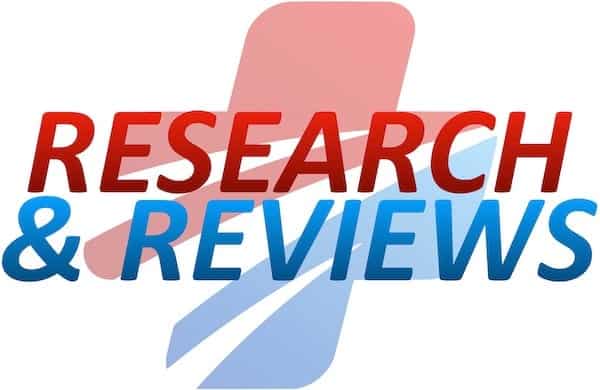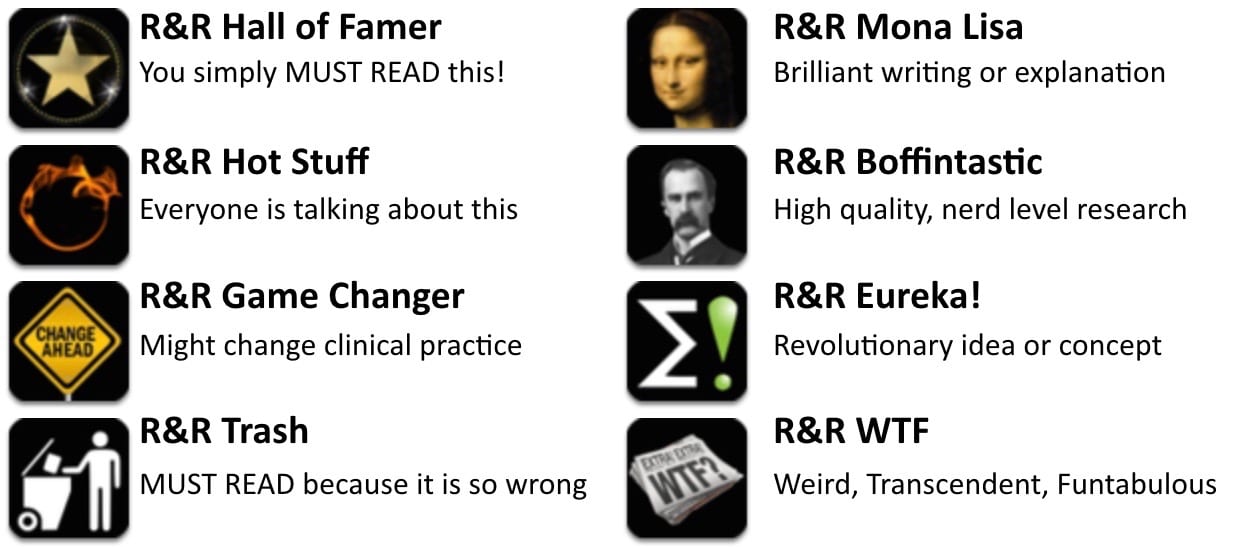R&R In The FASTLANE 029
Welcome to the 29th edition of Research and Reviews in the Fastlane. R&R in the Fastlane is a free resource that harnesses the power of social media to allow some of the best and brightest emergency medicine and critical care clinicians from all over the world tell us what they think is worth reading from the published literature.
This edition contains 8 recommended reads. The R&R Editorial Team includes Jeremy Fried, Nudrat Rashid, Soren Rudolph, Anand Swaminathan and, of course, Chris Nickson. Find more R&R in the Fastlane reviews in the : Overview; Archives and Contributors
This Edition’s R&R Hall of Famer
Abdo WF, Heunks LM. Oxygen-induced hypercapnia in COPD: myths and facts. Crit Care. 2012 Oct 29;16(5):323. [Epub ahead of print] PubMed PMID: 23106947
- This paper attempts to put to rest the myth of loss of hypoxic drive leading to type 2 respiratory failure when oxygen is administered to a COPD patient. COPD patients improve their gas exchange through hypoxic pulmonary vasoconstriction to alter their V/Q ratios – this is lost when excess O2 is given. Target SaO2 of 88 to 92% in these patients.
- Recommended by Joe Lex
- Learn more: LITFL CCC — Oxygen and Carbon Dioxide Retention in COPD
Cormack RS, Lehane J. Difficult tracheal intubation in obstetrics. Anaesthesia. 1984 Nov;39(11):1105-11. PubMed PMID: 6507827
- A classic that belongs in everyone’s collection.
- Recommended by: Joe Lex
Kerrey BT, Rinderknecht AS, Geis GL, Nigrovic LE, Mittiga MR. Rapid sequence intubation for pediatric emergency patients: higher frequency of failed attempts and adverse effects found by video review. Ann Emerg Med. 2012 Sep;60(3):251-9. doi: 10.1016/j.annemergmed.2012.02.013. Epub 2012 Mar 15. PubMed PMID: 22424653; PubMed Central PMCID: PMC3400706
- A sobering article highlighting the void between what actually happened (video review) and what was recorded in the written record in a large series of paediatric intubations in a tertiary emergency department. Many adverse effects were under-reported. Only 52% of intubations were successful on the first attempt illustrating the huge challenge faced by the occasional paediatric incubator and need for up-skilling in this area.
- Recommended by: Michael Baker
Abdo WF, Heunks LM. Oxygen-induced hypercapnia in COPD: myths and facts. Crit Care. 2012 Oct 29;16(5):323. [Epub ahead of print] PubMed PMID: 23106947.
- This paper attempts to put to rest the myth of loss of hypoxic drive leading to type 2 respiratory failure when oxygen is administered to a COPD patient. COPD patients improve their gas exchange through hypoxic pulmonary vasoconstriction to alter their V/Q ratios – this is lost when excess O2 is given. Target SaO2 of 88 to 92% in these patients.
- Recommended by: Joe Lex
Pollack CV, Schreiber D, Goldhaber SZ, Slattery D, Fanikos J, O’Neil BJ, Thompson JR, Hiestand B, Briese BA, Pendleton RC, Miller CD, Kline JA. Clinical characteristics, management, and outcomes of patients diagnosed with acute pulmonary embolism in the emergency department: initial report of EMPEROR (Multicenter Emergency Medicine Pulmonary Embolism in the Real World Registry). J Am Coll Cardiol. 2011 Feb 8;57(6):700-6. doi: 10.1016/j.jacc.2010.05.071. PubMed PMID: 21292129.
- PE mortality in this 1800 patient registry with PE was 1%. Either anticoagulation is the best treatment ever developed or the base line PE mortality isn’t as bad as we think it is.
- Recommended by: Andy Neill
- Learn more: EMI
Yuen CK, Mok KL, Kan PG. The validity of 9 physical tests for full-thickness rotator cuff tears after primary anterior shoulder dislocation in ED patients. Am J Emerg Med. 2012 Oct;30(8):1522-9. doi: 10.1016/j.ajem.2011.12.022. Epub 2012 Mar 3. PubMed PMID: 22386341
- OK so this isn’t the strongest paper in the world but it confirms a bias. At follow-up following shoulder dislocation, 9 clinical tests were applied to pick up rotator cuff tears followed by an USS as gold standard. The empty can test was the best (sens 90; spec 55). Obviously not great but the best of a bad bunch.
- Recommended by: Andy Neill
- Learn more: EMI
Bergeron JW. The crucifixion of Jesus: review of hypothesized mechanisms of death and implications of shock and trauma-induced coagulopathy. J Forensic Leg Med. 2012 Apr;19(3):113-6. doi: 10.1016/j.jflm.2011.06.001. Epub 2011 Jul 12. PubMed PMID: 22390994
- Christ’s mode of death?
- My theory: positional asphyxia
- Recommended by: Joe Lex
Pomero F, Dentali F, Borretta V, Bonzini M, Melchio R, Douketis JD, Fenoglio LM. Accuracy of emergency physician-performed ultrasonography in the diagnosis of deep-vein thrombosis. A systematic review and meta-analysis. Thromb Haemost. 2013 Jan 8;109(1):137-45. doi: 10.1160/TH12-07-0473. Epub 2012 Nov 8. PubMed PMID: 23138420
- A large meta-analysis for emergency physician performed ultrasound for DVT evaluation compared to radiology performed, vascular lab, radiology showing very high sensitivity and specificity >95% ! Emergency physicians can and SHOULD perform bedside ultrasound evaluation for DVT.
- Recommended by: Laleh Gharahbaghian
Seif D, Perera P, Mailhot T, Riley D, Mandavia D. Bedside ultrasound in resuscitation and the rapid ultrasound in shock protocol. Crit Care Res Pract. 2012;2012:503254. doi: 10.1155/2012/503254. Epub 2012 Oct 24. PubMed PMID: 23133747; PubMed Central PMCID: PMC3485910.
- New additions to the RUSH (rapid ultrasound in shock) protocol for all interested – M mode for LV contractility and EPSS evaluation!
- Recommended by: Laleh Gharahbaghian
- Learn more: Sonospot
Chris is an Intensivist and ECMO specialist at The Alfred ICU, where he is Deputy Director (Education). He is a Clinical Adjunct Associate Professor at Monash University, the Lead for the Clinician Educator Incubator programme, and a CICM First Part Examiner.
He is an internationally recognised Clinician Educator with a passion for helping clinicians learn and for improving the clinical performance of individuals and collectives. He was one of the founders of the FOAM movement (Free Open-Access Medical education) has been recognised for his contributions to education with awards from ANZICS, ANZAHPE, and ACEM.
His one great achievement is being the father of three amazing children.
On Bluesky, he is @precordialthump.bsky.social and on the site that Elon has screwed up, he is @precordialthump.
| INTENSIVE | RAGE | Resuscitology | SMACC








